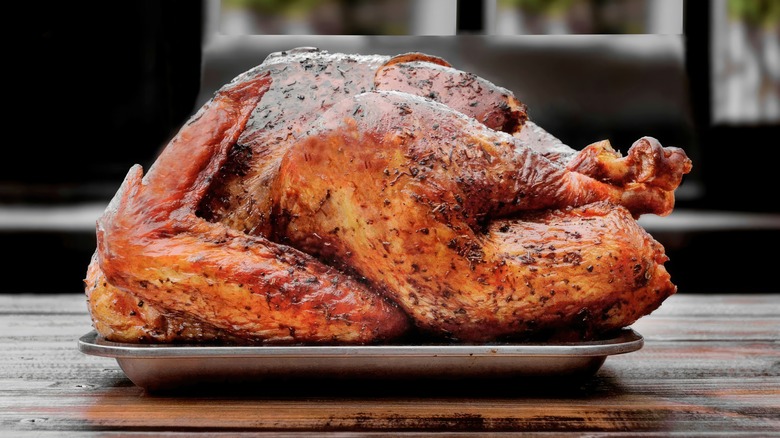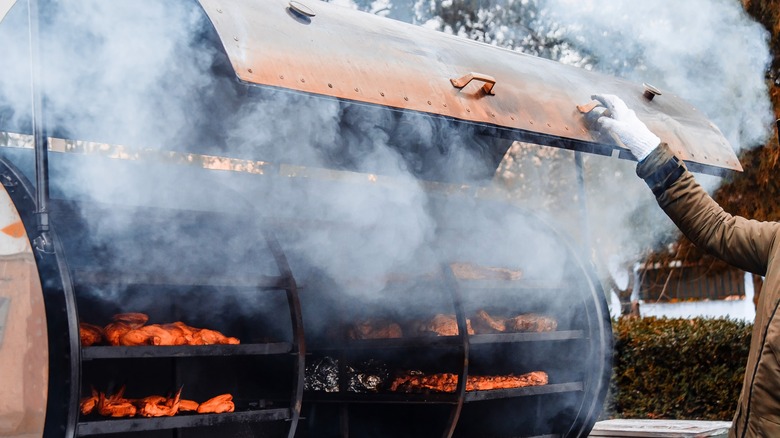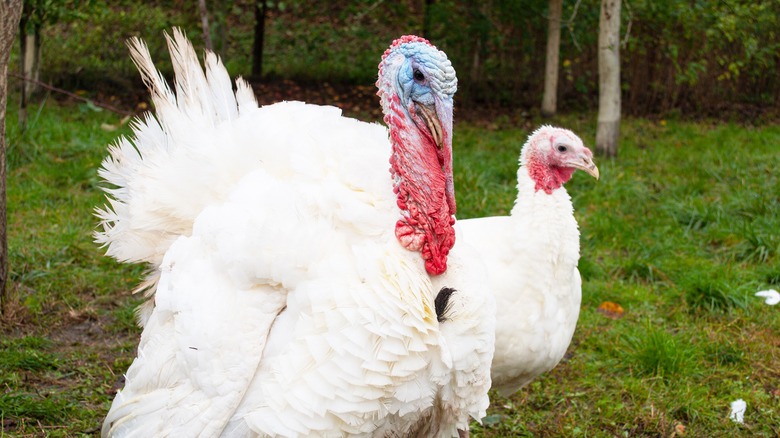Why Turkey Is A Cornerstone Of Texas BBQ - Exclusive
Turkey isn't just for Thanksgiving and smoked turkey isn't just for turkey sandwiches. Whether a whole bird, turkey breast, or legs, turkey is at home on the menu at Texas barbecue joints year-round. But why has turkey found a foothold where you might see chicken in other barbecue regions?
If anyone knows about turkeys and smoke, it is Robbie Shoults of Bear Creek Smokehouse in Marshall, Texas. He spoke to Tasting Table in an exclusive interview about the smoked turkeys that put his family on the map. Says Shoults, "In 1943, [my grandparents] got their first batch of turkeys and raised them. ... A couple of years later they started smoking and they just added on and added on."
The reason for Shoult's success, and turkey's significance in Texas barbecue tradition, is that these birds thrive in the region. European explorers first brought wild turkeys back from Mexico — later bringing their domesticated offspring to the East Coast. In fact, turkey fossils have been found in the southern U.S. and Mexico dating back more than 5 million years. Today, wild turkeys are still widely dispersed throughout the state, and Texan pitmasters have made the most of their bounty.
Turkeys take to smoke
Outside of Texas, most whole turkeys are roasted. If you've ever been responsible for the Thanksgiving centerpiece, you know how nerve-wracking it can be to try to get every part of the bird properly cooked without drying something else out. (May we suggest spatchcocking your turkey? You'll lose your Norman Rockwell presentation but will have much tastier results).
Smoking, however, eases a lot of that concern. By cooking at a lower temperature for a longer period of time, more moisture remains inside the turkey meat. More moisture and humidity means your chance of drying out the turkey breast is much lower, especially if you're keeping an eye on the internal temperature during the process. To really maintain moisture and infuse turkeys with flavor, brine before smoking.
Because this method of cooking was so favored, Shoults says his family's smoked turkey business continued to grow. "Every year they became more popular and before you know it, we were shipping turkeys all over the country," he shares.
It comes down to cost
Turkeys took over Texas smokehouses around the end of the Great Depression, as World War II began in Europe. Why? According to Robbie Shoults, it has a lot to do with cost. "My granddad had an uncle out in West Texas who was an ag teacher, and he told my granddad, 'You can put more pounds of gain on a turkey than you can hogs and cattle.' In other words, the feed conversion was better," he explained. Plain and simple, raising turkeys is less expensive than raising cattle and hogs, and pitmasters amid economic uncertainty stretched their dollars with culinary aplomb.
When it comes time to cook, the affordability of turkey can outweigh the price of brisket as the reward of a perfect burnt end also comes with a big risk. Brisket is notoriously difficult to cook. Specifically, because the muscle gets used so much while the cow is alive, it is full of fibers that require a lot of time and attention to be turned tender. With expertise and attention, a well-marbled brisket with a great fat-to-lean ratio can turn out great — but the opposite is also true. Shared Shoults, "If you've got your fork and your knife and you're trying to cut [barbecue] and it cuts like boot leather, you probably know you're at a bad spot."
Visit Bear Creek Smokehouse to learn more about their products.


